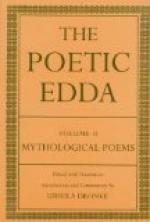The other motives of these stories may be briefly enumerated. The burning of Brynhild and Signy, and Sigrun’s entrance into the howe, are mythical reminiscences of widow-burial. The “sister’s son” is preserved in the Sigmund and Sinfjoetli tale, which also has a trace of animism in the werwolf episode. The common swanmaid motive occurs in two, the Voelund story and the legend of Helgi and Kara; while the first Helgi tale suggests the Levirate in the proposed marriage of Svava to her husband’s brother. The waverlowe of the Volsung myth may be traced back to the midsummer fires; the wooing of Brynhild by Sigurd’s crossing the fire would thus, like the similar bridal of Menglad and Svipdag and the winning of Gerd for Frey, be based on the marriages which formed a part of agricultural rites.
Bibliographical Notes
To avoid confusion, and in view of the customary loose usage of the word “saga,” it may be as well to state that it is here used only in its technical sense of a prose history.
Voelund. (Pages 5 to 8.)
Dr. Rydberg formulates a theory identifying Voelund with Thiazi, the giant who carried off Idunn. It is based chiefly on arguments from names and other philological considerations, and gives perhaps undue weight to the authority of Saxo. It is difficult to see any fundamental likenesses in the stories.
The Old English references to Weland are in the Waldere fragment and the Lament of Deor. For the Franks Casket, see Professor Napier’s discussion, with photographs, in the English Miscellany (Oxford, Clarendon Press, 1901). The Thidreks Saga (sometimes called Vilkina Saga), was edited by Unger (Christiania, 1853), and by Hylten-Cavallius (1880). There are two German translations: by Rassmann (Heldensage, (1863), and by Von der Hagen (Nordische Heldenromane, 1873).
The Volsungs. (Pages 8 to 27.)
As divided in most editions the poems connected with the Volsung cycle, including the two on Ermanric, are fifteen in number:
Gripisspa.
Reginsmal, Fafnismal, Sigrdrifumal, a continued narrative compiled from different sources.
Sigurd Fragment, on the death of Sigurd.
First Gudrun Lay, on Gudrun’s mourning, late.
Short Sigurd Lay (called Long Brynhild Lay in the Corpus Poeticum; sometimes called Third Sigurd Lay). style late.
Brynhild’s Hellride, a continuation of the preceding.
Second, or Old, Gudrun Lay, is also late. It contains more kennings than are usual in Eddic poetry, and the picture of Gudrun’s sojourn in Denmark and the tapestry she wrought with Thora Halfdan’s daughter, together with the descriptions of her suitors, belong to a period which had a taste for colour and elaboration of detail.




